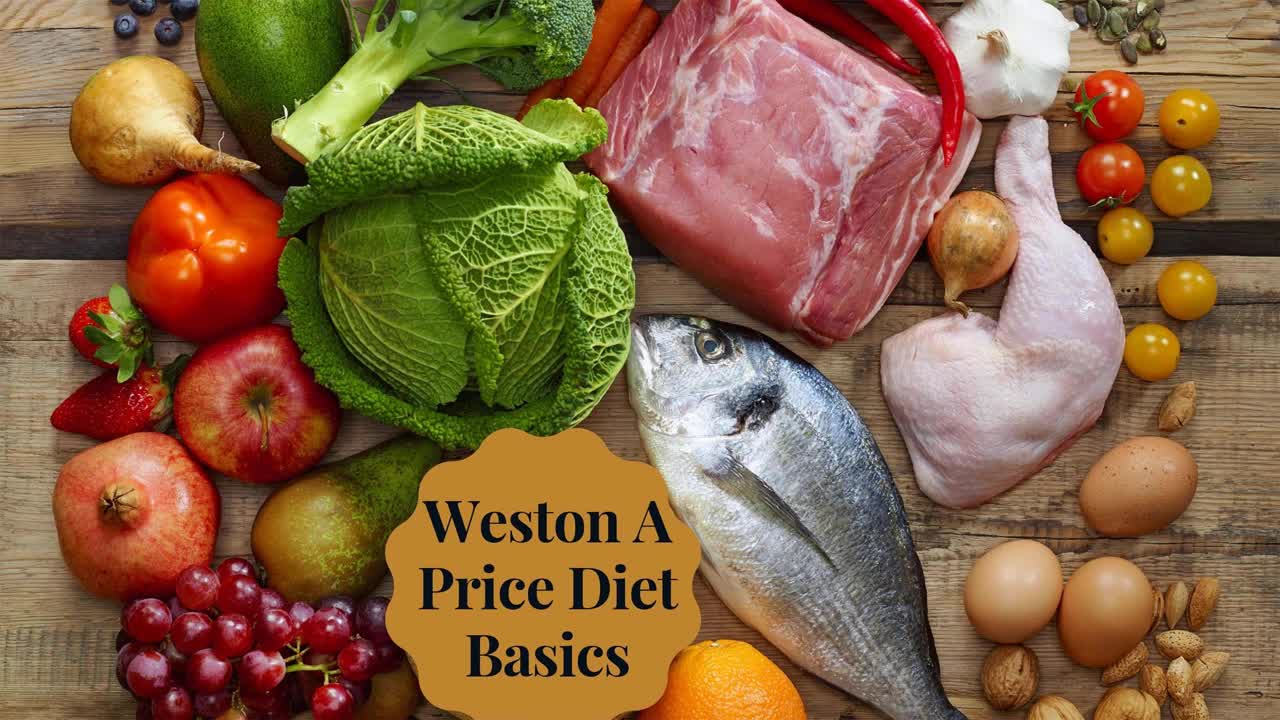Premium Only Content

Weston A Price Diet Basics
Today I’m going over the Weston A Price Diet Basics. They champion raw milk and have a lot of great information on their website. I’ll put a link in the show notes to their website.
Before I launch in to today’s info, I want to take a minute to say welcome to all the new listeners and welcome back to you veteran homestead-loving regulars who stop by the FarmCast every week. I appreciate you all so much. I’m so excited to share with you what’s going on at the farm this week.
Today’s Show
• Homestead Life Updates
• Weston A Price Diet Basics
• Bone Broth Recipe
Homestead Life Updates
I feel almost normal again. There was one small incident earlier this week. We are missing one small buck and I thought he might be in with the girls so I walked much farther out into the pasture than normal to round up the goats. It’s pretty easy to do but required a bit more energy that I anticipated. I walked slowly and carefully. Keeping good balance is still an issue. I’m very careful when walking around out there. So many things can trip you up if you are not paying close attention. Then, oops, trip and down you go. Fortunately, I did not have that experience. No, I just walked slowly and carefully. Unfortunately, I walked a lot farther than I had in quite a while. It seemed like it would be easy. After all, I often easily walked two or three times as far as I did on this morning prior to my bout of appendicitis. Well, turns out it wasn’t that easy. I continue to be surprised by how weak my body became with this illness. Oh well, I just went inside, cooled off, rested . . . and then made some cheese.
The Garden and Orchard
Both are showing the effects of a lack of rain this summer. Oh, and the steers ate the tops of my celery, sweet potatoes and the Swiss chard. Bummer, I was going to take the celery to the farmer’s market per the request of my customers. The sweet potatoes will likely be fine. In fact, the tubers may grow even larger as they are the propagation mechanism for the plant. Whenever a plant’s life is threatened, it begins to put a lot of energy into reproduction. For instance, when it gets to hot for lettuce and spinach in late spring, the plants will send up stalks of seeds. This is referred to as “bolting”. We say the lettuce or spinach “bolted”. Sometimes even the smallest amount of stress can cause lettuce and spinach to bolt. It starts putting out as many seeds as possible to preserve itself.
Scott did take a day out of this creamery-building schedule to water the few remaining veggies in the garden and the entire orchard. He also did a bit of summer pruning of the trees. And then it was back to laying blocks in the creamery.
The Creamery
It is so exciting to see those walls growing out of the ground. The building is really taking shape. Scott is so dedicated to using every possible minute to get the project completed. His attention to detail is also inspiring. The seams between the blocks are perfectly aligned. Visit our Facebook page to see images of all his hard work.
The Animals
We started the culling process with the goats. I talked about our plan in the podcast just prior to this one. In the end, we will have no sheep and the cashmere goats will be replaced with Kiko goats. We took the three breeding bucks to the meat processor. They will make lots of ground chev. Look for a good deal on soup bones. We will have lots of them.
All three of them had impressive racks of horns. Roanoke’s were more than 4’ feet from tip to tip. We asked and were granted permission to keep the heads with the horns attached. They are currently curing and will eventually decorate our walls – probably in the small store area of the creamery.
The Quail
We have begun collecting eggs for the next batch of quail. It started slow. Only two so far.
The quail cages got moved. Their manure smell is quite pungent and their cages were far too close to the carport and back door. The odor seemed to accumulate under the carport and came wafting to the back door.
Each time the quail are disturbed, they stop laying eggs for a few days. When Scott was building the cages, he had to remove the layers from their cages while he assembled the additional cage above their space. They stopped for a day or so and then slowly returned to their original laying pattern. So when Scott moved their cage to a new and quite lovely shady spot, their laying dropped to almost nothing. He brought in two eggs this morning. Normally, we get six to eight. Also, the days are getting shorter and the birds will naturally lay fewer eggs. They need light to lay every day. We can supply artificial light and we may do that. Who knows? That’s another project though. Best keep on with the creamery.
Weston Price Diet Basics
Today I want to talk about a traditional diet as presented by the Weston A Price Foundation. (WAPF). There are lots and lots of ideas and opinions about nutrition out there. The science cannot seem to agree. And it makes sense. No two people are alike. Some people live on the equator with ancestral and genetic ties to an abundance of fruits. Some people live in areas where meat and fat are their only choices. I recommend doing your own research and making your choices based on the needs belonging uniquely to you and your family.
Today, specifically, I’ll be outlining the recommendations detailed by the Weston A Price Foundation. First, some basics on the man and the organization.
Who is Weston Price?
Weston Andrew Valleau Price (September 6, 1870 – January 23, 1948) was a Canadian dentist known primarily for his theories on the relationship between nutrition, dental health, and physical health. He founded the research institute National Dental Association, which became the research section of the American Dental Association, and was the NDA's chairman from 1914 to 1928.
Price initially did dental research on the relationship between endodontic therapy and pulpless teeth and broader systemic disease, known as focal infection theory, a theory which resulted in many extractions of tonsils and teeth. Focal infection theory fell out of favor in the 1930s and was pushed to the margins of dentistry by the 1950s.
By 1930, Price had shifted his interest to nutrition. In 1939, he published Nutrition and Physical Degeneration, detailing his global travels studying the diets and nutrition of various cultures. The book concludes that aspects of a modern Western diet (particularly flour, sugar, and modern processed vegetable fats) cause nutritional deficiencies that are a cause of many dental issues and health problems. The dental issues he observed include the proper development of the facial structure (to avoid overcrowding of the teeth) in addition to dental caries. This work received mixed reviews, and continues to be cited today by proponents of many different theories, including controversial dental and nutritional theories.
The Weston A Price Foundation
The Weston A. Price Foundation (WAPF) was co-founded in 1999 by Sally Fallon Morell and nutritionist Mary G. Enig. It is a non-profit organization dedicated to "restoring nutrient-dense foods to the American diet through education, research and activism."
The foundation has been criticized by the U.S. Food and Drug Administration (FDA) for its advocacy of drinking raw milk and by various nutritionists for its advocacy of the health benefits of animal-based fats.
The President of the foundation is Sally Fallon Morell. The foundation has seven board members and numerous honorary board members, most of whom have medical or nutritional qualifications.
Its main sources of support are the dues and contributions of its members. It does not receive funding from the government or the food processing and agribusiness industries. It does accept sponsorships, exhibitors and advertising from small companies by invitation, whose products are in line with its principles. The sponsors include grass-fed meat and wild fish producers, as well as health product companies.
A 2004 report published by the foundation stated that it is dedicated to "restoring nutrient-dense foods to the American diet through education, research and activism", and "supports a number of movements that contribute to this objective including accurate nutrition instruction, organic and biodynamic farming, pasture feeding of livestock, community-supported farms, honest and informative labeling, prepared parenting and nurturing therapies."
Specific goals include establishment of universal access to certified raw milk and a ban on the use of soy in infant formulas. The organization actively lobbies in Washington DC on issues such as government dietary guidelines definition and composition of school lunch programs.
The WAPF publishes a quarterly journal called Wise Traditions in Food, Farming, and the Healing Arts, and an annual shopping guide which lists products made from organic, non-GMO ingredients and prepared using traditional and artisan methods.
WAPF Diet Basics
The diets of healthy primitive and non-industrialized peoples contain no refined or denatured foods such as refined sugar or corn syrup; white flour; canned foods; pasteurized, homogenized, skim or low-fat milk; refined or hydrogenated vegetable oils; protein powders; artificial vitamins or toxic additives and colorings.
I do want to point out that primitive cultures have health difficulties that our modern systems have overcome. Access to food and health care in the first world is amazing. Death in childbirth and early childhood death from things like pneumonia are still issues for the primitive tribes. Diet won’t fix that. Appendicitis like I had would have been a death sentence for these people without modern medicine. We truck food from one side of the country to the other. Importing and exporting food from and to all parts of the world is now commonplace. We do not have problems with access to food. Our problems might be characterized more as excess of food.
All traditional cultures consume some sort of animal protein and fat from fish and other seafood; water and land fowl; land animals; eggs; milk and milk products; reptiles; and insects.
In every traditional culture, some of the animal products are eaten raw.
Their location on the planet determines their diet. And as I mentioned earlier, some have access to an abundance of fresh fruit. For some fruit would be a year-round staple and for other it would be seasonal.
Because of the focus on the foods I just mentioned, primitive diets contain at least four times the calcium and other minerals and TEN times the fat soluble vitamins from animal fats (vitamin A, vitamin D and vitamin K2) as the average American diet.
There is an interesting connection between raw foods and the enzymes needed to digest them. Primitive and traditional diets have a high food-enzyme content from raw dairy products, raw meat and fish; raw honey; tropical fruits; cold-pressed oils; wine and unpasteurized beer; and naturally preserved, lacto-fermented vegetables, fruits, beverages, meats and condiments. Lacto-fermenting is an art form I’ll address for you in a later podcast.
Seeds, grains and nuts are soaked, sprouted, fermented or naturally leavened in order to neutralize their naturally occurring antinutrients. Phytic acid, enzyme inhibitors, tannins and complex carbohydrates are examples of antinutrients.
Most of today’s nutritionists insist that low fat is the way to go. But that’s not how we were able to survive to experience this modern era. The total fat content of traditional diets varies from 30% to 80%. Of total calories consumed, only about 4% come from polyunsaturated oils. That 4% comes from the naturally occurring oils in grains, pulses, nuts, fish, animal fats and vegetables. The balance of fat calories is in the form of saturated and monounsaturated fatty acids.
Traditional diets contain nearly equal amounts of omega-6 and omega-3 essential fatty acids. There is a lot of heady information out there about what food has what fat and in what ratio? Is there a balance of equal parts omega-6 and omega-3? Again, in traditional diets where animals are raised in harmony with nature and gardens are made fertile with naturally occurring compost, the balance of this fat and that fat is irrelevant. When using traditional methods of farming, the animals are healthy and the nutrition in food is naturally in balance. If it is not, something needs to change in the farming method. This is the essence of being sustainable.
All primitive diets contain some salt. Another vilified nutrient by today’s standards.
Traditional cultures consume animal bones, usually in the form of gelatin-rich bone broths. Bone broth is quite popular today in the keto and carnivore diet worlds.
That sums up the basics of the WAPF diet basics. Go to their website and signup for their 7-part Wise Traditions Diet to get all the information on eating a traditional diet. What to eat as well as proper preparation passed down through centuries of experience.
Bone Broth
Bone broth is made with bones that have bits of meat still clinging unlike “stock”. It is also generally thinner than “stock”. Most people use the terms interchangeably. It has been made for centuries. Roasted bones will add flavor to the broth and will darken the color.
This recipe that fresh herbs for an added bit of flavor.
What You Need
• 1 pound lamb bones or other bone of our choice
• 1 tablespoon cooking oil
• 1 large onion, diced
• 3 medium carrots, chunked
• 3 stalks celery, chopped
• 3 sprigs fresh rosemary
• 5 sprigs fresh thyme
• 3 gallons water, more as needed
• Salt, optional
What To Do
1. Preheat oven to 400 F.
2. Place bones in roasting pan. Cook for 30-40 minutes or until browned.
3. In a large stock pot placed over medium heat, add cooking oil.
4. Add onion, carrot, celery, garlic, and herbs. Saute for 5 minutes.
5. Add bones including fat and juices from the roasting pan.
6. Add enough water to cover the bones and bring it to a simmer. Reduce the heat to low.
7. Simmer for 8 hours (or up to 24 hours) uncovered. Add more water as needed to keep the bones covered.
8. Strain the broth through a fine mesh strainer lined with a tea towel.
9. Enjoy hot or store in the refrigerator for up to a week.
Notes
If you made a larger amount, freeze the remaining broth in container sizes that fit your everyday needs or pressure can for longer term storage.
Hop over to the website to find and print this recipe. There is a link in the show notes. Go to the home page, click or tap podcasts, click or tap this episode titled “Weston A Price Diet Basics,” scroll to the bottom of the post and you will find the link to the bone broth recipe.
Final Thoughts
That’s it for this episode of the Peaceful Heart FarmCast. We are winding down toward fall, the harvests are coming in and preserving food for the winter is in full swing here on the homestead. The work on the creamery continues. And as the days get cooler, that bone broth is the perfect food for bringing you warmth and peace at the end of the day.
If you enjoyed this podcast, please hop over to Apple Podcasts, SUBSCRIBE and give it a 5-star rating and review. And the best way to help out the show is to share it with any friends or family who might be interested in this type of content.
As always, I’m here to help you “taste the traditional touch.”
Thank you so much for stopping by the homestead and until next time, may God fill your life with grace and peace.
References
Weston A Price Foundation
Recipe Link
Bone Broth
To share your thoughts:
• Leave a comment on our Facebook Page
• Share this show on Twitter, Facebook and Instagram
To help the show:
• PLEASE LEAVE A REVIEW for Peaceful Heart FarmCast on Apple Podcasts.
• Subscribe on iTunes, Stitcher Radio, Google Play Music, TuneIn or Spotify
• Donate on Patreon
Website
www.peacefulheartfarm.com
Patreon
www.patreon.com/peacefulheartfarm
Facebook
www.facebook.com/peacefulheartfarm
Instagram
www.instagram.com/peacefulheartfarm/
-
 32:13
32:13
Uncommon Sense In Current Times
13 hours ago $0.13 earnedEXCLUSIVE: Antisemitism Is Spreading in America — Campuses to Congress | Rabbi Steve Weil Interview
6.83K4 -
 1:00:22
1:00:22
Trumpet Daily
19 hours ago $2.67 earnedPeace Derangement Syndrome - Trumpet Daily | May 20, 2025
7.88K7 -
 32:12
32:12
Steph & Kayls
16 hours agoUnfiltered Talks: Backdoor Adventures 🍑 & Dirty Requests | Ep. 6
7.36K1 -
 50:58
50:58
Lets Read!
1 day ago $1.84 earned3 More True Scary Private Investigator Stories
306K4 -
 2:55:43
2:55:43
TimcastIRL
10 hours agoIsrael Prepares To STRIKE Iran Nuclear Facilities Says US Intel | Timcast IRL
701K119 -
 1:28:53
1:28:53
Man in America
13 hours agoHow the Elites are Stripmining the Middle Class—So You'll OWN NOTHING w/ Tiffany Cianci
74.9K35 -
 LIVE
LIVE
Biscotti-B23
2 hours ago $0.13 earned🔴 LIVE SEASON 11 🔥 NEITO MONOMA IS HERE & NEW ALL MIGHT QUIRK SET 💥 MY HERO ULTRA RUMBLE
111 watching -
 1:08:18
1:08:18
Adam Does Movies
19 hours ago $6.88 earnedLAST Tuesday Night Movie Hangout At The Old Studio - LIVE!
73.9K4 -
 6:29:00
6:29:00
SpartakusLIVE
11 hours ago#1 Champion of Verdansk LADEN with TITANIC MUSCULATURE
84.3K2 -
 29:39
29:39
Producer Michael
17 hours agoI'VE NEVER SEEN SO MANY SUPERCARS IN ONE PLACE!
61.9K3